As the emergency of the spring 2020 semester ended and the uncertainty of the summer began, we commiserated—in text messages, on Zoom calls, and sitting many feet apart in each other’s yards—about our feelings of disconnection and our inability to focus on anything other than the pandemic. The scholarship we had started before the pandemic hit seemed far less urgent in light of COVID. Instead of forcing ourselves to ignore the pandemic in our work and forge on with our existing projects, we decided to use our academic energies to face the crisis directly. Working from our expertise in reflective writing (Lesley) and public memory (Laura), we designed the Iowa State University Quarantine Journal Project (hereafter QJP).
The QJP was designed to invite community members into a shared reflective experience that would ultimately become a public memory project. This pandemic was something we were all going through simultaneously; writers documented their experiences and reflected on this time in their journals. But the acute crisis would eventually end; we arranged to archive the journals so that we, and future generations, can remember. Writers completed the journals individually, but the QJP was a collective experience of reflection, documentation, and remembrance for the broader Iowa State University (ISU) community.
We chose to design a journal project because the moment we were living through together seemed ripe for reflective writing, and because we were able to issue an invitation to writers that we often cannot issue to student writers who are enrolled in our classes: use reflective writing, broadly conceived, in whatever ways serve you best, and do so only if you want to. Too often, reflective writing serves a bureaucratic function in institutional contexts; that is, reflective writing assignments are often required for courses and designed for student writers to perform themselves and their learning in ways that serve institutional assessment purposes and validate the curriculum (Jung 2011; Scott 2005). Much of the scholarship on reflective writing emphasizes how much student writers benefit from such assignments, but too often the institutional constraints of such writing subsume the benefits for student writers themselves (Bartlett, Forthcoming). With the QJP, we wanted to extend a different kind of invitation to reflect, and we think our invitation can serve as a flexible model for others who see the value in opt-in reflection.
The project was intentionally simple. In several conversations on Zoom and one long work session in distanced rocking chairs on Laura’s porch, we made choices about what kind of invitation we wanted to extend. Simplicity and flexibility emerged as priorities. We invited writers to share their stories, reflections, or drawings to help capture how this experience was changing the ISU community. Anyone who had an affiliation with ISU was welcome to participate. This included students, faculty, and staff, as well as alumni, relatives of ISU students or employees, and members of the broader Ames community. All writers received a package by mail with a small paper journal, simple instructions, and a stamped envelope to return their journal at the end of the project. We chose paper-based journals to encourage writers to differentiate this creative and reflective experience from the obligatory digital turns our lives had taken because of the pandemic.
Our cooperation with the ISU Special Collections and University Archives allowed us to characterize the journals as the creation of public memory artifacts. Public memory is an activity of collectivity—in its creation and in its reception. Our invitation to writers explained that their journals would ultimately be preserved in the University Archives and copied into their Digital Collections. Our invitation read: “The ISU Quarantine Journal Project is designed to document ordinary lives in an extraordinary moment in history. As the pandemic continues–and when it eventually becomes a memory–the broad strokes of this crisis will be easily preserved. But records of individual experiences will also be important for examining and reflecting on how our world has changed.” While the QJP responded to a particular exigence, our overall approach to this community-engaged writing project could be a model of a nimble response to events that affect our communities and warrant reflection and remembrance. We assume that most faculty members at colleges and universities with an active archive could collaborate with their library to store physical journals and potentially to digitize the material so that it is accessible off campus.
Prompts and Journal Examples
In the instructions we mailed to writers, we provided a wide range of prompts that we generated to help them think creatively and critically about how they could document their lives in the summer of 2020. While we hoped our prompts would help writers explore different aspects of their experience, the prompts were not meant to be restrictive. Our instructions stated, “You can also create your own questions or reflect on issues and ideas that our prompts haven’t covered.” Again, simplicity and flexibility were key parts of our invitation.
We generated the prompts together and borrowed one (with proper citation) from an online project that was recording pandemic life in a different way. Some of our prompts invited writers to document their daily lives, some invited reflection, and some nudged writers toward critique. Several of the prompts were designed to elicit the kind of information we imagined would interest future researchers and/or visitors to the University Archive: What’s an ordinary day like for you? What kinds of art have you been consuming? How would you describe your emotional life? How do you imagine you might live differently when the pandemic is over? We hoped that these journals would offer a glimpse into the experiences of individual people who lived through the pandemic and provide specificity to balance the statistics and sweeping narratives that often shape dominant historical accounts.
Of course, we will remember 2020 for more than our individual experiences of daily life during a global crisis. The pandemic foregrounded structural weaknesses and injustices in the US and beyond. Some of our prompts made way for writers to consider the range of inequities that were thrown into stark relief during the pandemic:
- Has this moment called you to social action? If so, how would you describe it?
- What kinds of help or support have you accessed during quarantine? What enabled you to access it? What kinds of help or support would you have liked to access during quarantine? What prevented you from accessing it?
- As the economy changes, are your ideas about work changing? Are your ideas about money changing? How has the pandemic affected how you think about value, worth, and work?
- How has the pandemic affected how you think about institutions like government, church, and school?
The act of documenting and reflecting on experiences in their journals was a collective, if socially-distanced, experience. While prompts like these explicitly invite writers to reflect on their own feelings and experiences, they also encourage writers to reflect on how the pandemic is affecting the broader community—and world. Questions like these suggest a different kind of connection, perhaps a more empathetic one, than simply participating in a socially-distanced collective writing experience. For example, the first prompt might invite writers to address the demands for a racial reckoning that were heard across the US in the summer of 2020, while the second prompt may encourage writers who accessed the support of a therapist to process the fear and isolation associated with quarantine to consider the barriers to access that other community members face.
The images below are excerpts from QJP journals (we obtained permission from each of these writers and gave them the option to remain anonymous). While several writers ignored our prompts altogether, as they were explicitly invited to do, many writers selected prompts from our list to guide their writing. The writer below followed prompts throughout their journal (Fig. 1). These pages were likely in response to the prompt that read, “How would you describe your emotional life during quarantine? Feel free to write and/or draw your response. Googling ‘feelings wheel’ and looking at the emotions listed might help you identify your emotions more precisely.” Note how this writer moves between individual and collective concerns in this entry.
Figure 1
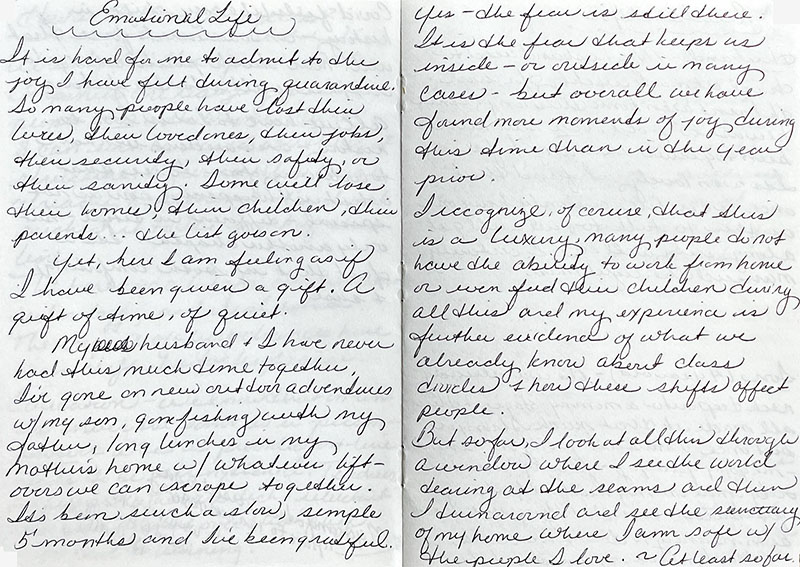
“It is hard for me to admit to the joy I have felt during quarantine. So many people have lost their lives, their loved ones, their jobs, their security, their safety, or their sanity. Some will lose their home, their children, their parents…the list goes on.
Yet, here I am feeling as if I have been given a gift. A gift of time, of quiet.
My husband + I have never had this much time together. I’ve gone on new outdoor adventures w/ my son, gone fishing with my father, long lunches in my mother’s home w/ whatever leftovers we can scrape together. It’s been such a slow, simple 5 months and I’ve been grateful.
Yes—the fear is still there. It is the fear that keeps us inside—or outside in many cases—but overall we have found more moments of joy during this time than in the year prior.
I recognize, of course, that this is a luxury, many people do not have the ability to work from home or even feed their children during all this and my experience is further evidence of what we already know about class divides + how these shifts affect people.
But so far, I look at all this through a window where I see the world tearing at the seams and then I turn around and see the sanctuary of my home where I am safe w/ the people I love. ~ At least so far.”
The following two writers combined responses to our prompts with a diary approach where they wrote about whatever was on their mind. These images are from maps those writers drew to document their daily spaces and movements (Fig. 2 and Fig. 3). They were likely responses to the prompt that said, “Draw a map or other visual representation of where you spend your time during quarantine. How has your perspective about your daily movements, your community, or the broader world changed over the last few months?” This prompt was inspired by CityLab’s collection of reader-created maps of their daily lives, communities, or the broader world during the pandemic (Bliss and Martin 2020). Drawing allowed these writers to communicate how the pandemic was changing their sense of space and their relationships to familiar spaces.
Figure 2
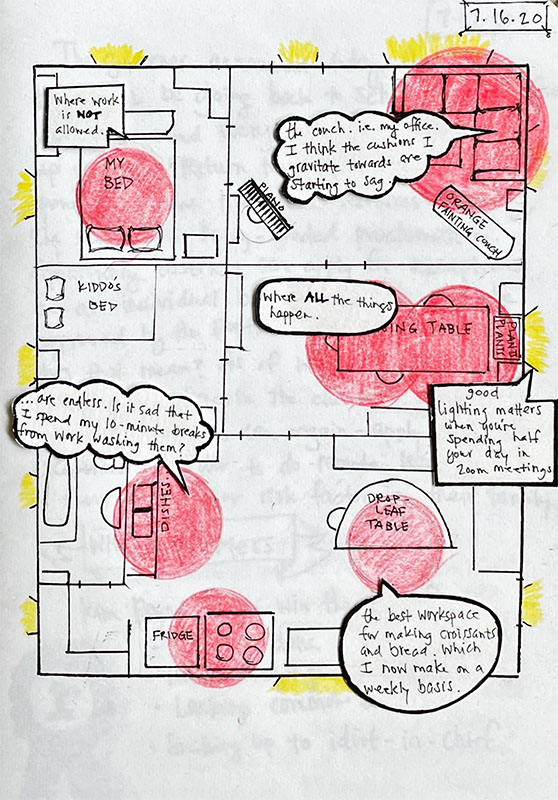
The writer has drawn a simple rectangle that represents the floorplan of her home, dated 7.16.20. She has labeled and colored red circles over the areas where she spends the most time. Comment bubbles explain how she has used those spaces. She has drawn yellow lines bursting out of the windows to represent the natural light that comes into her home. The bedroom is in the top left corner. There is a red circle over “My Bed,” and a comment bubble says, “Where work is NOT allowed.” In the top right corner she has sketched a piano and a rectangle labeled “Orange Fainting Couch.” An L-shaped couch fits into the top corner, covered by a large red circle. The comment bubble here says “the couch. i.e. my office. I think the cushions I gravitate towards are starting to sag.” The middle left room is for “Kiddo’s Bed.” The middle right room is mostly taken up by the dining table, which is covered in two red circles, one of which also includes a small table labeled “Plants / Plants.” A comment bubble over the table reads “where ALL the things happen.” Another points to the window next to the plant table: “good lighting matters when you’re spending half your day in Zoom meetings.” The kitchen spans the bottom of the floorplan. There is a red circle over the sink, which is labeled “Dishes…” She finished the thought in a comment bubble: “… are endless. Is it sad that I spend my 10-minute breaks from work washing them?” A second red circle overlaps the fridge and stove, and a third covers the “drop-leaf table.” A comment bubble there reads “the best workspace for making croissants and bread. Which I now make on a weekly basis.”
Figure 3
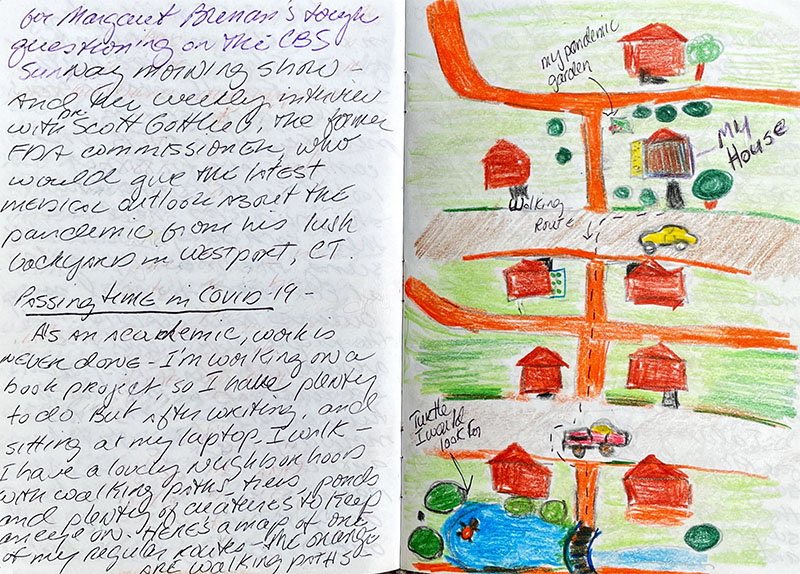
Image description: The left page picks up a previous entry mid-sentence: “…for Margaret Brenan’s tough questioning on the CBS Sunday [halfway through the word “Sunday” her pen appears to run out of purple ink and she begins writing in a black ink] Morning Show – And her weekly interview with Scott Gottlieb, the former FDA Commissioner, who would give the latest medical outlook about the pandemic from his lush backyard in Westport, CT.”
A new entry begins halfway down the page under the heading “Passing time in COVID-19.” It ends mid-sentence and continues on a page not pictured here. “As an academic, work is never done—I’m working on a book project, so I have plenty to do. But after working, and sitting at my laptop, I walk—I have a lovely neighborhood with walking paths, trees, ponds and plenty of creatures to keep an eye on. Here’s a map of one of my regular routes—the orange are walking paths— …”
The right page is map, hand drawn with colored pencil. Two brown roads cut across the page horizontally, with three orange walking paths between them. Another walking path runs vertically down the center of the page. The background is green to represent grass, and she has drawn simple houses in the spaces between the roads and the walking paths. One house, near the top right corner, is labeled “My House.” It is more detailed and colorful than the other houses; a small green square in the backyard is labeled “my pandemic garden.” A dashed line labeled “Walking Route” leads from the house down the walking path to a bridge that crosses a blue pond. In the pond is a turtle with an orange shell labeled “Turtle I would look for.”
Other writers developed their own prompts. This writer provided a structure for himself for days when he had “nothing else to say” (Fig. 4). The last image is from this same writer’s journal (Fig. 5). Note how he switched from typing to handwriting for his exclamation, a sentiment many of us no doubt shared during quarantine.
Figure 4
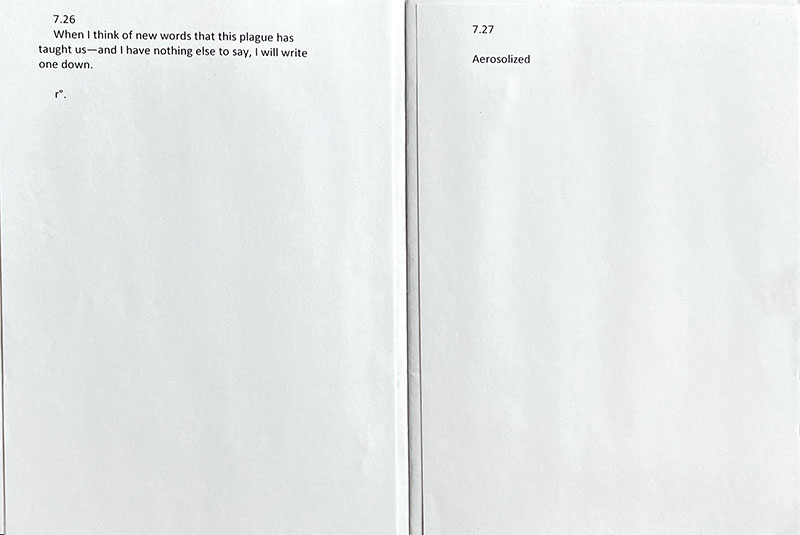
Image description: This writer has typed and printed each entry, then physically cut and pasted the pages into his journal. This image shows a two-page spread with one entry on each page.
The left page reads:
“7.26
When I think of new words that this plague has taught us—and I have nothing else to say, I will write one down.
r°”
The right page reads:
“7.27
Aerosolized”
Figure 5
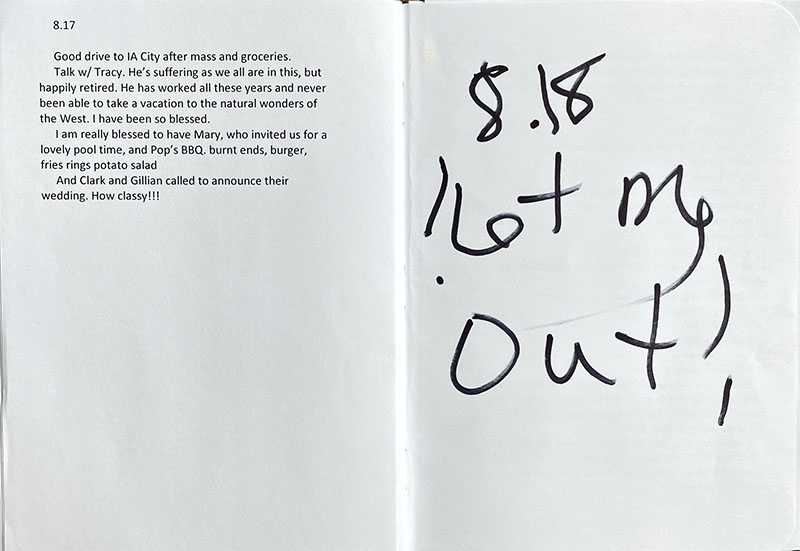
Image description: This image is another two-page spread from the same writer. The entry on the left page is typed, printed, cut, and pasted into the journal as in Fig. 4. It reads:
“8.17
Good drive to IA City after mass and groceries.
Talk w/ Tracy. He’s suffering as we all are in this, but happily retired. He has worked all these years and never been able to take a vacation to the natural wonders of the West. I have been so blessed.
I am really blessed to have Mary, who invited us for a lovely pool time, and Pop’s BBQ. burnt ends, burger, fries rings potato salad
And Clark and Gillian called to announce their wedding. How classy!!!”
The right page is nearly filled with large handwriting in thick black marker. It reads:
“8.18
!Let Me Out!”
These are just a few examples from the collection of journals that came out of the QJP. Soon, all of the journals will be available in the ISU Digital Collections (Iowa State University Library Digital Initiatives n.d.).
The Future of the QJP
In time, we imagine the journals functioning as public memory texts—records of how the pandemic pushed the ISU community into a kind of “collective…precarity” as the material conditions of our lives changed dramatically (Pauszek 2019, 51). The QJP was an invitation for community members to participate in building an archive “based on their expertise and embodied experiences” (Pauszek 2019, 52, emphasis in original). Expressions of public memory (how a community preserves and memorializes its past) can “narrat[e] a common identity,” at least momentarily defining a group (Blair, Dickinson, and Ott 2010, 7). Our project attempted to create a sense of collectivity in two ways. First, the writers were connected to one another, even though they never met in person. Each writer understood that they were part of a group who was recording their experiences and that their contributions would be preserved together. While social distancing precluded the usual forms of community building, the QJP offered a way for these writers to be in community with each other. Second, once the journals are available through the university archives, the project will offer a snapshot of (a small portion of) the ISU community whereby broader audiences—now and in the future—can see themselves in relationship to these writers. Ultimately, audiences may or may not identify with QJP writers, but engaging with their journals invites audiences into community with this group of writers, nonetheless.
We do not mean to suggest that ordinary people are automatically “authentic bearers” of history. Instead, as rhetoric and public memory scholar Ekaterina V. Haskins argues, they are “subjects whose identities are continuously formed and reformed through a complex process of enculturation and rhetorical negotiation” (2015, 6). On the one hand, these journals record individual perspectives that sometimes challenge the official university statements about what was happening in our community during the summer and early fall of 2020. Because these writers were connected to one another through their relationship to ISU, the QJP functions, in part, to demonstrate how the university refracted the experience of this crisis for the ISU community. These writers’ stories and reflections are a way to level some of the power dynamics that will inevitably shape narratives about how ISU navigated the pandemic.
On the other hand, the QJP did not “originate from without…the rituals and discourses” of this institutional culture. Instead, the project “engage[d] from within” (Haskins 2015, 6). The QJP—in its design, in writers’ contributions, and in the preservation of the journals—was inevitably shaped by the policies and practices of the university. We generated the project in response to a grant from a center on campus, and we used that grant to purchase the materials to make and mail the journals. We used email lists within our department and college to invite writers to participate (our materials were limited, so we decided not to extend the invitation further). The timeline for the project was determined by our academic calendar; we asked writers to return their journals just after the start of the Fall 2020 semester. Even our flexible approach to reflective writing was influenced by a desire to oppose the usual institutionalized forms of reflective writing that we are sometimes compelled to assign.
The future of the journals will also be determined by our institutional context. We designed the project to be preserved in the University Archives and worked with archivists to ensure that we were obtaining proper permissions from writers. The journals will become part of the ISU Libraries’ “COVID-19 Stories” collection, which will include oral history interviews and other submissions from members of the ISU community. We will not be able to decide how the journals are organized, described, and tagged within that larger collection. The University Archives’ existing digitization and filing practices will dictate how the journals are made available in their digital and physical collections. Each of these choices will inevitably affect how the material is accessed and used (Graban, Ramsey-Tobienne, and Myers 2014; Rawson 2018).
Archives often create an injurious distance between the texts and objects housed in an archive and the people these texts and objects claim to represent, stripping communities of agency in an effort to maintain epistemic norms (Cushman 2013). Working within these institutional constraints, we designed the QJP to preserve writers’ agency as much as possible. Our invitation and instructions to writers explained that the journals would be stored in the University Archives and made publicly available in the library and online. Unlike many artifacts stored in archives, the journals are not objects that have been detached from their original purpose or use. Instead, writers made the decision to request a journal, to write in the journal, and then to send their journal and consent form back to us. (Many writers opted not to use or return their journals–we mailed out 75 journals and received 22 back at the end of the project.) Each writer decided when and how their work will be made available in the University Archives, and they had the option to maintain copyright or transfer copyright to the university. Looking back on the project, we could have further supported writers’ choices by offering more detail about the University Archives and how their journals might be accessed and referenced. We likely overestimated many writers’ level of familiarity with archives and archival material (Graban, Ramsey-Tobienne, and Myers 2014).
In an effort to further acknowledge and explain our institutional parameters, we are submitting materials from our end of the project along with writers’ journals. We will include information about our grant, our proposal, our invitation to participate, and the instructions we mailed to writers. These materials expose the “information infrastructure” that shaped the QJP (Rawson 2018, 331). The project’s design is inevitably a reflection of what we were thinking and feeling during the summer of 2020 and how we imagined it would feel to look back on that period of time.
Conclusion
Writing this article one year after we developed the project, some elements already feel like reflections of the past. “Quarantine” no longer describes the kind of precautions we take to keep ourselves and our families safe from COVID-19. With vaccines widely available in the US, we have been able to see each other indoors again. We’ve written most of this essay at Lesley’s kitchen table, grateful to be able to work where we can escape the summer heat.
The QJP emerged from a specific set of circumstances. We wanted to use what we know about writing, rhetoric, reflection, and public memory to help some self-selected members of our community—and ourselves—process the collective precarity of the pandemic. We did not design the QJP as a research study that was meant to answer a specific question about reflective writing or public memory. If there’s anything we did design the project to do, it was to extend an invitation to connect—to pursue community in a moment when we were being pulled apart from each other.
It is no accident that we designed the QJP in a simple and flexible way that focused on the needs and desires of the humans who opted into the journaling experience. The QJP was funded by a small “Sheltering the Storm” grant from the Center for Excellence in Arts and Humanities (CEAH) at ISU; the call for proposals essentially said, “Would you like to make something in response to what is happening in the world? Tell us about it. We trust you.” This ethos no doubt influenced our approach to the QJP, and we’re grateful that the generous invitation the CEAH issued prompted us to issue a similarly generous invitation to writers.
The pandemic is an extreme example of a circumstance that isolates individuals from their communities, but it is not the only example. We imagine that similar projects could enact community during periods of change, tension, or renewal at educational institutions. Projects like the QJP prompt reflection, document ordinary lives, and invite people to use writing to connect to their own humanity and the humanity of others. We used what resources we had available to us to create an opportunity for individuals to reflect on their own lives and, crucially, to consider how their experiences are bound up with others inside and outside of their immediate communities.
Acknowledgements
Thank you to the QJP writers who took us up on our invitation. Thank you to Greg Bailey, University Archivist, and Daniel Hartwig, Head of Special Collections and University Archives at ISU, for their help and enthusiastic support of this project. Our work was supported by the Center for Excellence in the Arts and Humanities at ISU through their “Sheltering the Storm: Processing COVID-19” grants. We would also like to thank editors Steve Parks and Jessica Pauszek for their support of this essay.
References
Bartlett, Lesley Erin. Forthcoming. “Performing Reflection in Institutional Contexts: A Genre Approach to Compelled Reflective Writing.” In Writing the Classroom: Pedagogical Documents as Rhetorical Genres, edited by Stephen E. Neaderhiser. Logan: Utah State University Press.
Blair, Carole, Greg Dickinson, and Brian L. Ott. 2010. “Introduction: Rhetoric/Memory/Place.” In Places of Public Memory: The Rhetoric of Museums and Memorials, edited by Greg Dickinson, Carole Blair, and Brian L. Ott, 1-56. Tuscaloosa: University of Alabama Press.
Bliss, Laura, and Jessica Lee Martin. 2020. “How 2020 Remapped Your Worlds.” Bloomberg CityLab, June 18, 2020. https://www.bloomberg.com/features/2020-coronavirus-lockdown-neighborhood-maps/.
Cushman, Ellen. 2013. “Wampum, Sequoyan, and Story: Decolonizing the Digital Archive.” College English 76 (2): 115-135. https://www.jstor.org/stable/24238145.
Graban, Tarez Samra, Alexis Ramsey-Tobienne, and Whitney Myers. 2014. “In, Through, and About the Archive: What Digitization (Dis)Allows.” In Rhetoric and the Digital Humanities, edited by Jim Ridolfo and William Hart-Davidson, 233-244. Chicago: University of Chicago Press.
Haskins, Ekaterina V. 2015. Popular Memories: Commemoration, Participatory Culture, and Democractic Citizenship. Columbia: University of South Carolina Press.
Iowa State University Library Digital Initiatives, n.d. “Iowa State University Digital Collections.” Iowa State University. https://digitalcollections.lib.iastate.edu/.
Jung, Julie. 2011. “Reflective Writing’s Synecdochic Imperative: Process Descriptions Redescribed.” College English, 73 (6): 628–647. https://www.jstor.org/stable/23052365
Pauszek, Jessica. 2019. “Writing From ‘The Wrong Class’: Archival Labor in the Context of Precarity.” Community Literacy Journal 13 (2): 48-68. http://doi.org/10.1353/clj.2019.0010.
Rawson, K.J. 2018. “The Rhetorical Power of Archival Description: Classifying Images of Gender Transgression.” Rhetoric Society Quarterly, 48 (4): 327-351. http://doi.org/10.1080/02773945.2017.1347951
Scott, Tony. 2005. “Creating the Subject of Portfolios: Reflective Writing and the Conveyance of Institutional Prerogatives.” Written Communication, 22 (1): 3–35. http://doi.org/10.1177/0741088304271831
